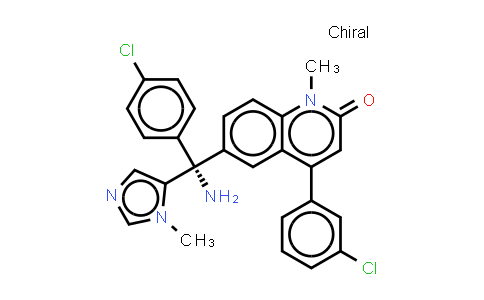| Chemical Name |
Tipifarnib |
| CAS Number |
192185-72-1 |
| MDL Number |
MFCD07772347 |
| Molecular Formula |
C27H22Cl2N4O |
| Molecular Weight |
489.40 |
| Synonyms |
R115777;IND 58359 |
Introduction of 192185-72-1 :
Tipifarnib (R115777; IND 58359) is a nonpeptidomimetic quinolinone with potential antineoplastic activity. Tipifarnib (R115777; IND 58359) binds to and inhibits farnesyltransferase (FTase) with IC50 of 0.6 nM. IC50 & Target: IC50: 0.6 nM (FTase) In Vitro: Tipifarnib (5 μM) leads the percentage of apoptotic cells significantly higher in drug-treated compared to DMSO-treated LGL T-cells. Using T-cells from healthy donors, tipifarnib reduces the percentage of IFNγ-positive cells in a time-dependent manner. Tipifarnib reduces the amount of activated Ras in precipitates compared to DMSO[2]. Tipifarnib exerts selective in vitro toxicity against clonal MDS hematopoiesis at concentrations less than 10 nM the effect being more prominent in white cell progenitors. This action is not due to apoptosis induction as both normal and MDS progenitors displays equivalent DiOC3 and annexin V expression up to 72 hours after exposure to Tipifarnib[3]. Combining Tipifarnib with 10 nM 4-OH-tamoxifen in the presence of E2 reduces the IC50 8-fold from 400 to 50 nM[4]. Tipifarnib induces apoptosis in U937 cells[5]. In addition, Tipifarnib inhibits isolated human farnesyltransferase for a lamin B peptide and for the K-RasB peptide with IC50 of 0.86 nM and 7.9 nM, respectively[6]. In Vivo: Tipifarnib has the light of the modest toxicity in patients and the potent reduction of graft-versus-host disease in mice, and it could help to reduce graft-versus-host disease significantly without having a negative impact on immune reconstitution[1]. Combined therapy with tamoxifen and Tipifarnib (50 mg/kg, p.o.) produces greater tumor growth inhibition when compared with either drug alone. E2 deprivation and Tipifarnib in combination results in greater growth inhibition than either E2 deprivation or Tipifarnib alone. The combination of tamoxifen and Tipifarnib results in significantly lower Ki-67 compared with either tamoxifen or Tipifarnib alone. Tipifarnib alone also reduces the CTI compared with control. The combination of tamoxifen and Tipifarnib or Tipifarnib coupled with E2 withdrawal is most effective at lowering the CTI (0.8 and 0.7, respectively), which may account for the decrease in tumor volume[4].
| Purity |
NLT 98% |
| Storage |
at 20ºC 2 years |
*The above information is for reference only.
